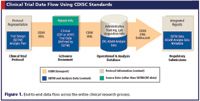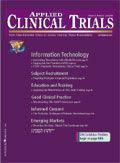CDISC Standards: Enabling Reuse Without Rework
Applied Clinical Trials
A single, industry-wide standard could streamline the clinical trial information management process.
Conducting clinical research rapidly and cost effectively is the dream of every biopharmaceutical company. But there's more to it than just ensuring activities are completed in a timely manner and without additional expense, or even that a drug spends the maximum time on the market once it is approved. Biopharmaceutical companies want to make sure that their treatments are safe and efficacious, and that risks to the intended patient population are kept to a minimum. An essential ingredient for improving the clinical trials process is an information management approach based on industry standards.
Standards support industry best practices
Currently, many clinical development programs are plagued by data quality problems, duplicate data entry, and excessive transformations from one format to another that steal time and introduce errors. Interest in using industry standards for the collection, organization, and submission of clinical trials data is certainly growing, but is not yet ubiquitous. Based upon work in other industries, Gartner reported that automating processes and using data interchange standards can produce significant benefits in process efficiencies and could save the biopharma industry between $5.8 and $6.6 billion dollars per annum (this number was calculated using the industry's 2004 spending on R&D and Gartner's average of the percent of R&D costs attributable to clinical trials).1
Nonetheless, a robust and defendable business case is required so that biopharmas can make decisions on the optimal process stage and implement data interchange standards in the context of clinical development.

With that goal in mind, CDISC, working with the support of Pharmaceutical Research and Manufacturers of America (PhRMA) and Gartner, undertook a research project to:
- collect information on current environments and processes that influence standards implementation and adoption
- collect available metrics
- estimate costs for implementation
- develop an estimate of potential savings
- identify benefits that may not immediately translate into cost savings
- assess the impact of implementation on the development process.
Through a series of interviews with biopharmaceutical company representatives and service providers, a baseline of information for current processes, personnel, time, and cost required to conduct clinical trials and other processes within the clinical development continuum was collected. Following the interviews, an online survey was conducted to capture additional metrics. In this article, we present an initial high-level summary of the findings thus far. The complete results will be reported in future communications.
Issues and potential benefits
The interviewees were familiar with the CDISC standards and how they enhance the end-to-end data flow across the clinical research process (Figure 1). By utilizing the CDISC Operational Data Model (ODM) as a transport standard, data about the protocol and study data collected on subjects can flow seamlessly through the entire clinical trial process—from source to analysis/reporting to regulatory submission and electronic data archive. The data content and metadata are structured using the Study Data Tabulation Model (SDTM), which can be transported via the ODM.

Figure 1. End-to-end data flow across the entire clinical research process.
Common issues expressed as problems in a process without standards relate to the disruption in the data flow shown in Figure 1. Many sponsors expressed the belief that standards could provide a significant improvement in their clinical development process. They pointed to a reduction in the time required to:
- create case report forms and the database
- program edit checks
- clean the data in an ongoing manner
- lock the database after last subject visit
- program a table or develop an SAS program
- train new employees
- conduct regulatory reviews.
Additional benefits
Many sponsors indicated that standards also offer some difficult to quantify benefits, such as the ability to:
- write a more robust protocol faster
- devote more time to the science behind the trial, not just the data
- help people understand their jobs better
- enable better communication among the various teams involved in the clinical trials process, including as data management, clinical operations, and statistics
- reconcile and report on adverse events across a series of clinical trials
- perform cross-trial analyses
- eliminate data transformations and rework
- cull out unnecessary work and improve trial design
- ensure consistency from one step in the process to another
- minimize redundant data sets and data flows
- reduce the chances of errors and inconsistencies
- permit the population of a data warehouse across trials/programs.
Contract research organizations (CROs) spoke of similar issues, as well as the problem of dealing with multiple sponsors who all have their own ways of doing things. They cited problems such as:
- multiple formats for case report forms and databases
- multiple vocabularies that must be reconciled
- difficult data exchange among partners.
CROs thought that standards would help them alleviate many of these problems. They cite significant decreases in set-up time for trials if they can use standards from case report form design through the reporting stage of the trials.

What's next for business case development?
The next steps in the business case project are to review in depth the information gleaned during the interviews and combine it with the information gathered through the online survey. Typical scenarios can then be developed so biopharmas can select a standards implementation path that will best meet their situation. The best practices will also be detailed.
What's next for CDISC standards?
One of the challenges mentioned by many of the biopharmas during the interviews was the concern that the standards were not stable or that they would change frequently, thus requiring constant upgrades.
To address this concern, CDISC is committed to maintaining the production standards and to making any enhanced versions backwardly compatible. They are also documenting how the standards work together. The technical roadmap for CDISC includes the development of one common, harmonized standard that will ensure ease and consistency across the full life-cycle of a clinical trial. Hence, efforts are underway to align the various CDISC models throughout the data flow process. This year, CDISC reorganized from seven standards-development teams into three focus areas:
1) maintaining the production standards;
2) providing implementation support and services; and
3) continuing to innovate (in particular working on a common overarching model to support research and health care).
The SDTM and Analysis Data Model (ADaM) have matured to a point that the industry expects to use them in ways that will streamline submission and facilitate regulatory review of the data. To test this concept, a pilot project is underway to produce a mock submission using the CDISC standards. The project will illustrate how the various CDISC components can be used to create an electronic submission in a format that is acceptable to the FDA and meets the needs of medical and statistical reviewers. The submission will include SDTM datasets, relevant metadata, ADaM analysis datasets and results, and an abbreviated report as supported by ODM and Define.XML.
Project status results will be presented at PharmaSUG 2006; results of the first iteration will be presented at CDISC Interchange in September 2006.
With a single common standard, data will flow even more seamlessly from protocol representation through the capture of source data to submission and archive. "The CDISC Standard" will comprise a set of fully integrated and consistent models that will form logically and organically from the current set. It will also provide an important link with health care standards to better serve sites, subjects, and all other stakeholders.
References
1. Gartner, "The Business Case for CDISC Standard," presented at the 41st Drug Information Association Annual Meeting, Washington, DC, June 2005.
Carol Rozwell* is vice president & distinguished analyst with Gartner Life Sciences Industry Advisory Services, (508) 651-9806, email: carol.rozwell@gartner.comwww.Gartner.com. Rebecca Kush is president of CDISC. Edward Helton is chief scientist regulatory and biomedical affairs with SAS and is on the CDISC Board of Directors.
*To whom all correspondence should be addressed.

Improving Relationships and Diversifying the Site Selection Process
April 17th 2025In this episode of the Applied Clinical Trials Podcast, Liz Beatty, co-founder and chief strategy officer, Inato, discusses a number of topics around site engagement including community-based sites, the role of technology in improving site/sponsor relationships, how increased operational costs are impacting the industry, and more.